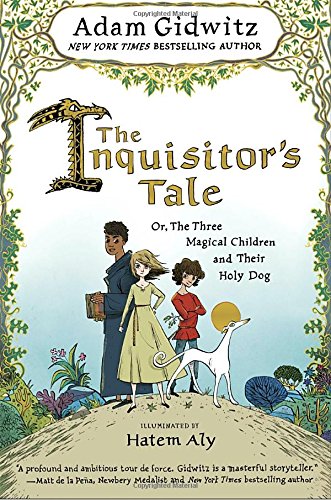The Inquisitor’s Tale: Or, The Three Magical Children and Their Holy Dog by Adam Gidwitz.
 I hate books that seem to say, “Oh, kids like gross, nasty, slimy stuff. Let’s take the really loathsome parts of this tale and make them the centerpiece of the narrative because that will draw the kids in.” That’s what I wrote about Mr. Gidwitz’s book, In a Glass Grimmly, and it applies to this story, too. It’s a shame that this author has such a penchant for poops and farts and crude humor because otherwise he’s a good writer. The scatological attempts at humor aren’t usually very funny, and they just don’t add to the story at all.
I hate books that seem to say, “Oh, kids like gross, nasty, slimy stuff. Let’s take the really loathsome parts of this tale and make them the centerpiece of the narrative because that will draw the kids in.” That’s what I wrote about Mr. Gidwitz’s book, In a Glass Grimmly, and it applies to this story, too. It’s a shame that this author has such a penchant for poops and farts and crude humor because otherwise he’s a good writer. The scatological attempts at humor aren’t usually very funny, and they just don’t add to the story at all.
The story: On a dark night in the year 1242, travelers from across France cross paths at an inn and begin to tell stories of three children: Jeanne, a peasant girl who has visions, William, an oblate who is half-Saracen and half French, and Jacob, a Jewish boy with a gift for healing. These children may be saints, or they may be using evil magic to do wonders that will deceive the faithful. And the dog, Gwenforte, who once saved a child from a deadly serpent, may be resurrected, but can a dog really be a saint? The children’s adventures take them from a farting dragon to a meeting with the king to a plot to save the illicit, mostly Jewish, books that are scheduled for burning by Good King Louis and his mother, Blanche of Castile.
So, Louis IX and his mother were real people, and so were several of the other characters in the novel. The three children are composite character, partly taken from the hagiographic stories of medieval saints and partly from Mr. Gidwitz’s fertile imagination. Other real medieval characters in the book include: Chretien de Troyes, a late 12th century poet and trouvare, Francis Bacon, the late medieval (1561-1626) scientist and philosopher, Rabbi Rashi of Troyes, an 11th century Jewish scholar, and various other minor characters imported from the pages of medieval French stories and poems. In addition, the girl, Jeanne, bears an affinity to Joan of Arc, the storytelling reminds one of Chaucer, and the burning in Paris of some 12,000 manuscript copies of the Talmud and other Jewish books actually took place in 1243.
So, as he did in his other series of books based on Grimm’s fairy tales, Mr. Gidwitz took the elements from several French, and even British, lives and tales of the middle ages and stirred them into a stew which turned out to be something completely different. And it could have been a delight. Instead, it’s sort of a mish-mosh of good scenes and bad, crude and insightful, funny and flat. If I could extract the bad parts and leave in the good, I would recommend it.
The illustrations, or illuminations, that adorn the pages of this medieval tale are a delight.
Pingback: Trends and Themes in Middle Grade Speculative Fiction 2016 – Semicolon